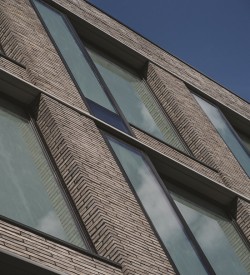FP McCann's structural precast concrete building and architectural façades division has supplied the complete package of architectural precast cladding components on a brand new office and retail development in Shoreditch High Street, London.
Covering an area of 35,819sq ft, the new building comprises five floors of offices spanning a ground floor and basement containing retail outlets including a restaurant/cafe. Undertaking the construction on behalf of client Max Barney Development Ltd, main building contractor Montway has recently completed the 525-day project designed by 21st Architecture, with the original design drawn as handset brickwork.
Working with an in-situ concrete frame, FP McCann was sent the design brief for the architectural façade panels, consisting of both grey brick and acid-etched finished concrete.
In total, 249 individual units were supplied from FP McCann's Littleport factory over a 10-week period and installed using a single tower crane, eliminating the use of any scaffolding on the building. Over 33,000 individual handmade bricks each measuring 528mm long x 40mm high were cast on at the factory, making 221 cladding panels totalling 623sq m and pointed with mortar - colour as specified by the architect. The 28 acid-etched panels (243sq m) for the side of the building facing the car park were colour matched to the brick façade.
Additionally, FP McCann supplied the corner and 'L' shaped precast brickfaced concrete columns consisting of 130m³ of concrete. To allow for fixing of the cladding panels that were secured floor by floor, FP McCann designed and supplied bespoke brackets. The architectural façade team at FP McCann worked closely with the engineers and architects on the project to ensure all aspects of the build met the exacting client specification.
Commenting on the completed project, Anthony Kelly, Project Manager for Montway says: "This method of architectural precast concrete/brickfaced construction demonstrates a number of efficiencies compared with practices associated with a traditional build. The offsite manufacturing of the building components offers significant advantages in terms of product quality and integrity. On site, speed of construction, minimising waste and the ability to work uninterrupted in all weather conditions are all major benefits. Additionally, the external façade system removes the need for scaffolding and wet trades, thereby minimising the health and safety risk factors associated with people working at height."









